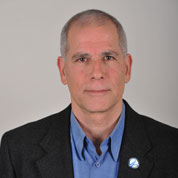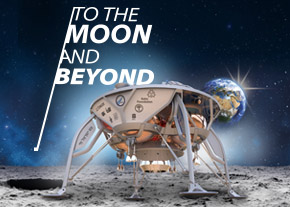
It’s been a disappointing few weeks for the Israeli space sector with the loss of Amos-6 and the troubled Ofek launch, but Eran Privman, CEO of SpaceIL – the Israeli outfit competing in the Google Lunar XPrize – is undeterred and is ready to take Israel to the Moon. SpaceWatch Middle East contributor Roy Isacowitz recently sat down with Eran Privman for an interview:
We believe that the recent explosion of a SpaceX Falcon 9 rocket with its Israeli payload will not affect SpaceIL’s plans to land a spacecraft on the moon by the end of 2017, says the company’s CEO Eran Privman.
SpaceIL, which was founded six years ago by three young Israeli engineers, is one of 15 teams from around the world participating in Google’s Lunar XPRIZE Challenge, which will pay U.S.$20 million to the first privately-funded team to reach the moon by 31 December 2017.
Privman expresses himself cautiously on the recent explosion, which destroyed the Israel-made Amos 6 communications satellite. SpaceIL’s launch contract, announced in October 2015, is with SpaceX and the designated rocket is the Falcon 9. Therefore, Privman acknowledges, SpaceX’s ability to recover from the accident could clearly impact SpaceIL’s plans.
That said, he notes that the SpaceIL spacecraft is due to be launched from a launch pad in California – rather than the Florida pad that was damaged in the accident – and that SpaceX has an inventory of rockets to cover the recent loss.
He also points out that SpaceX resumed launching relatively quickly after a rocket exploded shortly after launch in June last year, with eight launches in 2016 alone. At this stage, SpaceIL believes that SpaceX will be able to fulfill the launch contract and is not looking at other launch options.
It’s clear that Privman believes SpaceIL will overcome the latest hurdle and will be the first team to make it to the moon.
The major components of the team’s spacecraft, which weights 600 kilograms and is the size of a washing machine, are currently being built by the Israel Aerospace Industries, which also built the ill-fated Amos 6.
But, whereas the Amos 6 was a satellite – like all Israeli spacecraft launched to date – the SpaceIL craft is not. In that it is unique. It is the first Israeli spacecraft designed to reach a target and fulfill a mission, rather than to go into orbit and provide communications or surveillance services.
Or, to put it another way, it is the first Israeli spacecraft designed to go into deep space, rather than into orbit around the earth at a distance of some 500 kilometers. The moon is 1,000 times further from earth, necessitating the development of new technologies and opening up a new domain for the Israeli space industry.
Privman is certain that the acquisition of deep space capability will be of enormous benefit to Israeli science, including the development of low-cost technologies for commercial use. He is candid enough to acknowledge that he can’t enumerate all the forms that benefit will take, pointing out no-one could imagine today’s commercial air travel at the time that Lindbergh made his trans-Atlantic flight.

“Pioneering creates its own opportunities,” Privman says.
SpaceIL’s launch date is in December 2017, Privman says – only days before the competition’s 31 December deadline. Only two of the other contenders for the Google prize have also announced launch contracts – Moon Express and Synergy Moon, both American companies and both also scheduled to launch in December 2017.
Potentially, the skies around the moon could become crowded in December next year, though Privman does not believe that all 15 companies will make it to launch. He expects only about five launches, including those by the German and Indian teams, which he regards as Israel’s main competitors.
Privman says that SpaceIL has identified a number of potential landing spots, all of them relatively flat and on the same latitude, to avoid the high temperatures at the moon’s equator. The actual spot will depend on the precise position of the moon at launch date, which will affect trajectories.
The competition requires that the spacecraft must make a soft landing on the moon, transmit high definition still photographs and video back to earth, travel at least 500 meters and then again transmit high definition still photographs and video back to earth from the new position.
Rather than meet the travel requirement by building a rover of some sort, as most of the other competitors are doing, SpaceIL has opted to fly (or hop) the required 500 meters, using the spacecraft’s propulsion system and remaining fuel.
In addition to the U.S.$20 million prize to the winner, another U.S.$5 million will go to the team that completes the mission second, and U.S.$5 million in bonus prizes will be awarded to teams achieving additional goals – such as lasting through the lunar night and reaching the landing spot of one of the Apollo missions from 1969 to 1972.
The SpaceIL spacecraft has not been designed to last the lunar night, Privman says, though it may turn out to do so. A full day on the moon is 30 earth days – 15 earth days for the lunar day and another 15 for the night. The plan is to complete the mission by noon of the lunar day, i.e. in seven earth days. Much of the time will be taken up with the transmission of the high-definition stills and video, given the distance involved (some 400,000 kilometers) and the very small size of the lander’s transmitter.
Nor is the team planning to land at an Apollo landing site, due to the heavy fuel requirements of landing at a precise spot. Fuel will be the spacecraft’s most valuable commodity and it will need to be conserved to accomplish the 500 meter hop.
In addition to the activities required by the Google competition, the SpaceIL spacecraft will also conduct an experiment focused on the moon’s magnetic fields, in an effort to gain knowledge into how it was created.
That experiment throws light on the company’s second mission: In addition to creating new technologies and winning the Google competition, Space IL is also dedicated to educating Israeli youth and instilling in them enthusiasm for space, science and technology. It aspires to create an Israeli “Apollo effect” (the effect that the United States Apollo missions had on youth in the 1960s and 1970s,) inspiring Israeli youth to challenge themselves and to further their education in science, technology, engineering and math.
By landing a spacecraft on the moon, SpaceIL will be an enabler of the future, Privman says. “Our kids will have to take the next steps.”
SpaceIL is a non-profit organization, supported by donations from private and corporate sponsors. Among its major donors are the Kahn Foundation, the Adelson Family Foundation, the Israeli telecommunications giant Bezeq and the Israel Aerospace Industries, which have provided the project with facilities.
The company has announced that, if it wins the competition, the prize money will be channeled into education. Asked what will become of the company after the competition, Privman smiles. Continuing its educational mission is certainly on the cards; he won’t say whether there will be additional technological challenges. Right now, SpaceIL is focused on landing on the moon.
One of the legacies of SpaceIL, Privman says, will be to put Israel shoulder-to-shoulder with the US, Russia and China as the only nations that have put a spacecraft on the moon. Until now, Israel has focused entirely on putting satellites into orbit; the moon mission will be the country’s first venture into deep space.
Two weeks ago, SpaceIL hosted a summit in Tel Aviv of all 15 teams competing in the moon challenge and Google, the sponsor. It was the last in a series of summits at which the teams got together to swap experiences and celebrate their successes. Now, they are in the final stretch. The next get-together will be on the surface of the moon – for those who make it.
SpaceWatch Middle East contributor Roy Isacowitz is a journalist and writer based in Tel Aviv. Born in South Africa, he currently works for the Israeli daily newspaper Haaretz.
Original published at: http://spacewatchme.com/2016/09/interview-eran-privman-israels-spaceil-ready-play-big-boys/
 SpaceWatch.Global An independent perspective on space
SpaceWatch.Global An independent perspective on space

